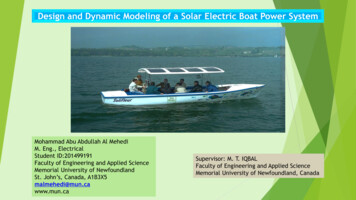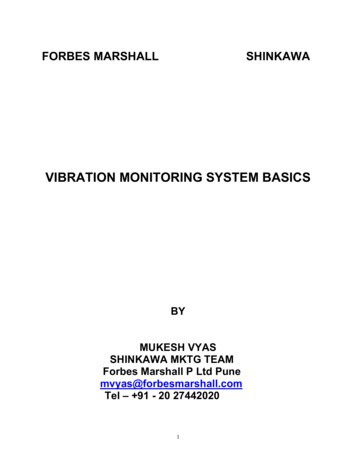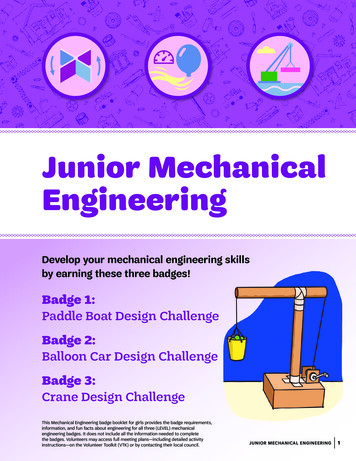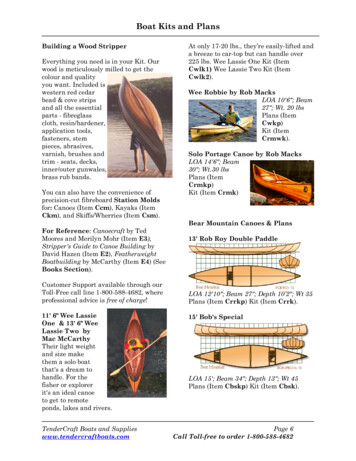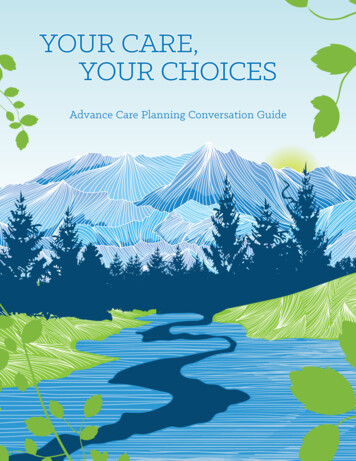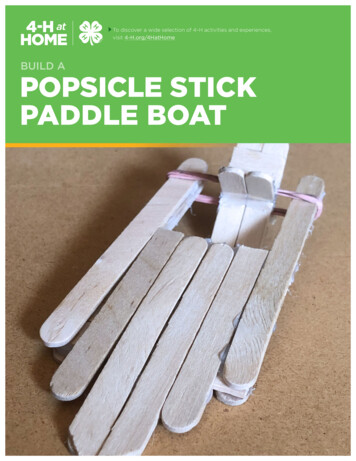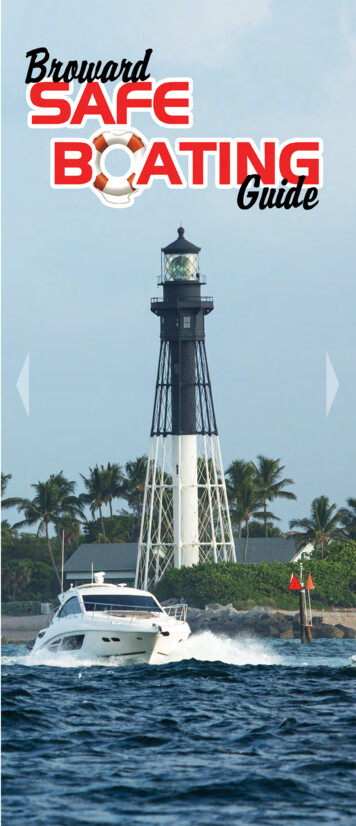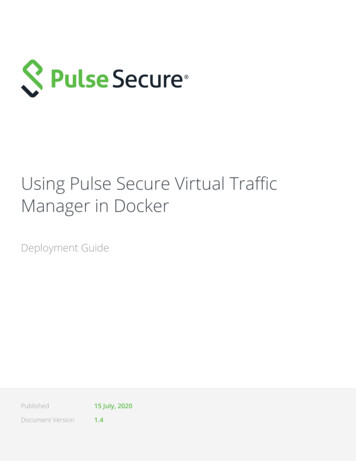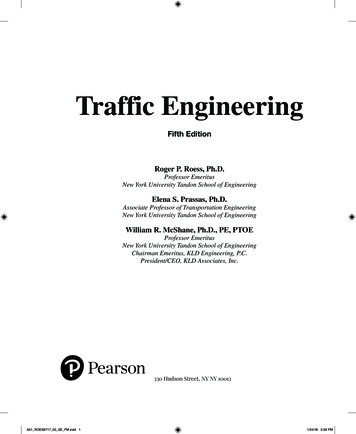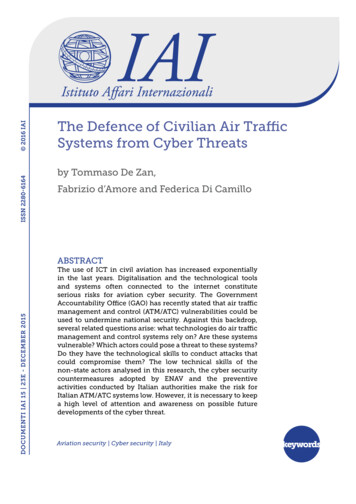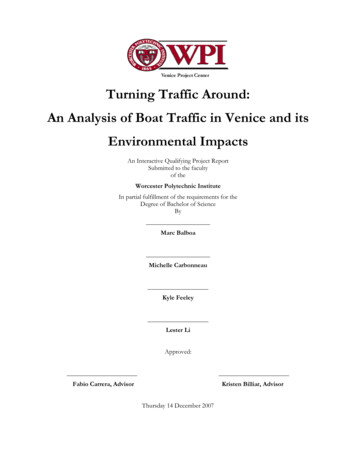
Transcription
Turning Traffic Around:An Analysis of Boat Traffic in Venice and itsEnvironmental ImpactsAn Interactive Qualifying Project ReportSubmitted to the facultyof theWorcester Polytechnic InstituteIn partial fulfillment of the requirements for theDegree of Bachelor of ScienceByMarc BalboaMichelle CarbonneauKyle FeeleyLester LiApproved:Fabio Carrera, AdvisorKristen Billiar, AdvisorThursday 14 December 2007
Authorship PageThis project was completed with the equal participation of each team member. Withoutfull cooperation and effort provided by each team member, this project could not have beensuccessfully completed.
Acknowledgementso We would like to thank the members of our families whose support made itpossible for us to take advantage of this wonderful opportunity.o Thanks to our advisors, Sensei Fabio Carrera and Professor Kristen Billiar, fortheir time and patience throughout.o Thanks to the staff at Forma Urbis, Daniela Pavan, Andrea Novello, and AlbertoGallo for taking their time to help us out behind the scenes.o We are grateful to the Redfish group for letting us use their model and for theirinsight into complex traffic analysis.o Thanks to COSES and ARPAV for making their field data available for use in ourproject.o We acknowledge the work of the Moto Ondoso Index project team.o A special thanks to “Coffee Guy” for providing the best espresso we‟ve ever had,to the good people of C‟e Pizza e Pizza for being open Sunday nights whennothing else was, and to the wonderful ladies at the Crazy Bar for not charging toeat in.
AbstractThis project contributed to the ongoing development of an autonomous agent model ofVenetian boat traffic by collecting detailed turning-movement counts at 17 intersections andupdated indices for boat produced noise and wake pollution. These intersections had neverbefore been studied nor had any of their traffic-related environmental concerns been assessed.The team identified the major contributors of each pollution type and recommended speed limitenforcement and more efficient traffic regulation as methods by which to mitigate potentialenvironmental concerns.
Executive SummaryVenice has a unique traffic system in that the primary means of vehiculartransportation is boats. This, however, does not exempt Venice from some of the same problemsthat the average major city faces. Like other cities, Venice is subject to traffic-related noisepollution and congestion. Unique to Venice, though, is Moto Ondoso, otherwise known as wakepollution, which has the “destructive potential to sink the city.”1Traffic count studies pioneered by WPI are undertaken semiannually by COSES, a cityorganization dedicated to research and advancement. These counts facilitated our analysis which,in the future, will allow city officials to make more informed decisions regarding trafficrestriction and regulation. Data concerning noise and wake pollution output by boat type hasbeen taken in various studies in Venice. Not much has come of the collected data and littleenvironmental analysis has been completed.The project group sought to increase the amount of traffic knowledge by conductingadditional field counts at previously uncounted locations. Combining this information with pasttraffic count studies, the group increased the accuracy of current Venetian traffic models andFigure 1: Map shows increased accuracy with the addition of our datainvestigated the environmental impacts of traffic. The picture above displays a difference of 240boats between two major counting locations. Without field data at potential turning points inbetween, a model would have to guess how the boats distributed in order to account for the1Professor Fabio Carrera
disparity. Instead of inaccurately assigning equal value to each intermediate intersection, thecorrect number of boats that turned at each location can be used due to field data collected by theproject team.The traffic count locations were selected based on the criteria that they are integral toinner canal traffic flow and had not yet been counted. Working in groups of two, we countedboats in accordance with the methodology created by WPI and presently employed by COSES.Working during peak traffic hours, boats and their maneuvers were counted and categorized bytype.Using past traffic count studies alongside existing noise and moto ondoso pollution data,the group calculated index values for each pollution type at various locations throughout thecanal system. These values were quantitatively ranked and used to create gradient mapspresenting areas of high and low pollution. This moto ondoso gradient map shows areas of high(red) and low (yellow) wake pollution. As might be expected, the highest levels of wakepollution are along the Grand Canal and Rio Novo.Figure 2: Moto ondoso gradient mapIt was determined that boat traffic volume is not necessarily directly proportional to theamount of pollution in any given area. For example, pollution impacts of ten gondole and tencargo ships are quite different. While the gondole contribute heavily to traffic congestion, theyproduce virtually no pollution. Conversely, turismo boats generally travel at high speeds andcontribute a high percentage of the total pollution.
These pie charts present the percentage contribution by boat class to total traffic side byside with the percentage contribution to moto ondoso pollution. Turismo boats account for onlyBoat Traffic smo40%Figure 4: Noise pollution by boat classGondola0%Moto mo49%Figure 3: Moto ondoso contribution by class40% of the total traffic and yet they are responsible for nearly half of the canal system‟s wakepollution.The environmental effects of traffic can be easily mitigated through improved regulationand stricter law enforcement. The project group concluded that excessive speed is a majoritycontributor to boat-produced noise and wake pollution. Further study evaluating specificpollution contribution by boat type would be instrumental in better understanding the cause of,and solution to, traffic related environmental concerns. Additionally, the project grouprecommends additional seasonal traffic count studies be undertaken as they provide thefoundation upon which all other traffic related issues may be meaningfully analyzed.
Table of Contents1.Introduction. 132.Background. 143.2.1Traffic . 152.2Venetian Boat Types . 152.3Traffic Count Studies . 172.4Moto Ondoso Index. 182.5Noise pollution studies . 202.6Autonomous Agent Model . 222.7Book Chapters . 22Methodology . 223.1Area of Study . 233.2Traffic Counts . 243.2.13.33.3.13.43.4.14.5.6.Traffic Count Limitations . 25Moto Ondoso Index. 26The Moto Ondoso Index. 26Noise Index. 27Noise Pollution Study Limitations . 273.5Spatial Extension. 283.6Longitudinal Analysis . 28Results and Analysis . 294.1Traffic Counts and Turning Movements at Intermediate Intersections . 294.2Moto Ondoso Index and Major Contributing Boat Types . 294.3Noise Pollution Index and Major Contributing Boat Types . 32Conclusions and Recommendations . 345.1Traffic . 345.2Moto Ondoso . 355.3Noise Pollution. 36Bibliography. 37
List of FiguresFigure 1 . 13Figure 2 . 14Figure 3 . 15Figure 4 . 15Figure 5 . 16Figure 6 . 16Figure 7 . 17Figure 8 . 17Figure 9 . 18Figure 10 . 18Figure 11 . 19Figure 12 . 21Figure 13 . 23Figure 14 . 23Figure 15 . 24Figure 16 . 25Figure 17 . 29Figure 18 . 30Figure 19 . 31Figure 20 . 31Figure 21 . 33Figure 22 . 33Figure 23 . 33Figure 24 . 35
List of EquationsEquation 1 . 26Equation 2 . 27
List of TablesTable 1: Example data sheet . 24Table 2: Moto Ondoso index values . 30Table 3: Noise index values . 32
List of AppendicesAppendix A: Boat Type Field Guide. .A-1Appendix B: Longitudinal Analysis Graphs . .B-1Appendix C: IQP Station Count Locations . . .C-1Appendix D: Total Volume by Boat Class . .D-1Appendix E: Moto Ondoso by Boat Class . . . . E-1Appendix F: Noise Volume by Boat Class. . . F-1Appendix G: Turn Percentages . .G-1Appendix H: Venetian Traffic . H-1Appendix I: The Impacts of Traffic on Venice .I-1
1. Introduction2City traffic is considered most often in terms of heavy congestion as a result of the workcommute. This pattern is referred to as the origin/destination traffic model. The traffic is, in turn,simulated with this in mind. Unregulated traffic would pose a serious threat both to people and tothe environment. Therefore traffic laws, regulations, and speed limits are often investigated andaltered.Trafficisoftenoverlooked but it is very much anintegral part of the city. Forexample,WashingtonD.C.experiences a 73% populationincrease as a result of nonresident traffic.3Venice is no differentfrom other major cities of theworld in that traffic directlyaffects every facet of daily life.Figure 5: Typical traffic congestion2There is, however, one uniquedivergence.Carsarenotallowed in Venice; all of the city‟s vehicular traffic is due to boats. While some aspects of typicaltraffic considerations apply, many do not. Venice is interwoven with nearly 150 canals throughwhich boats travel daily.4 A thorough understanding of this boat traffic can lead to vastimprovements throughout the city. Similar to car traffic, boats also pollute the environment. Themost prevalent forms of such pollution are water, noise, and wake.Water traffic results in a variety of potential dangers which, when better understood, canbe reduced to an acceptable level. Previous research has measured some of these dangers. Bydetermining the average energy output and volume of boats by type at various locations, an indexwas created that identifies areas of high wake pollution. In addition, ARPAV observed boats atvarious locations and recorded their decibel outputs at various speeds and accelerations during ahttp://truckphotos.freeservers.com/traffic jam.jpghttp://money.cnn.com/2005/10/21/real estate/buying selling/daytime population cities4 Carrera, Fabio and Caniato, Guiovanni; "Venezia la Citta Dei Rii23
sixteen hour period. Finally, traffic counts are taken semiannually at over twenty locationsthroughout the city (Figure 17).Traffic count data has yet to be taken at many intermediate canal intersections. Thoughdata exists for high trafficintersections,thereisinsufficient data to accuratelysimulatetrafficbehaviorthrough the inner canals. Tothis end, boat traffic counts attheinnerincreasecanalswouldknowledgeabouttraffic flow through the entirenetwork.Currently, a teamfrom the Santa Fe Institute isdeveloping an autonomousagent model which reliesFigure 6: Venetian traffic congestionheavily upon traffic data toaccurately simulate the manner by which boats navigate the canals. With a better understandingof Venice‟s traffic, the previously collected pollution data can be used as a proxy to evaluate theenvironmental impacts of said traffic.The most recent traffic count data will be used to update the moto ondoso index and tocreate a noise pollution index. With the addition of our traffic counts, our goal is that theautonomous model will become more intelligent and allow us to construct precise pollutionindices based on more realistic numbers. Additionally, an accurate simulation is invaluable incases of emergency planning and can be used more broadly to increase traffic efficiency.2. BackgroundThe project team studied boat traffic at intermediate canals in Venice and itsenvironmental impacts. In order to become more familiar with these topics the team researchedsome general information about Venice, boats, traffic, and related types of pollution. Included inSection 2 are important topics relevant to boat traffic counts, boat pollution, and the Venetiancanal system.
2.1TrafficFor centuries Venetians sole mode of transport through the canal system was humanpowered boats. Seeing as rowboats create no wake pollution, the possibility of erosion leadingto collapse was never taken into consideration. However, since the advent of motor boats, thepopulation of rowboats has become nearly extinct. Waterborne traffic as a primary means oftransportation has lead to a unique traffic paradigm.Traffic patterns are primarily influenced by origin and destination. For instance, traffic ina major city depends most heavily upon the commute to and from work. Weekend and afternoontraffic are predisposed more towards leisure and consumer activities. Venice traffic, though, issignificantly different from that which most experience. Residents of Venice commute to workon foot or by means of public transportation. For this reason, Venetian traffic does not fit thetypical model. The traffic in Venice that fits the origin-destination model is characterized by thedelivery of goods to stores which accounts for 36% of Venice‟s traffic.A significant portion of Venice‟s traffic results from taxis.In fact, taxi/publictransportation accounts for 46% of the total traffic.5 This is almost completely fueled by thetourism industry, which provides Venice with 70% of its yearly income. With 18 million touristsevery year and growing, there has never been more stress put on the environment and Venice‟s150 canals.62.2Venetian Boat TypesThe many boats travelling daily through the canals in Venice fit categorically into 21types as seen in Appendix B. It is important tocategorize them this way as they serve differentpurposes and contribute differently to pollution.The first two types are reserved for cargoFigure 7: Cargo boat (Type 2)boats, large and small respectively. Similar to delivery trucks on the highway, these cargo boatstravel the same routes over and over again delivering itemsthroughout the city. For considerations of traffic analysis,they are linked together in a class named cargo.Figure 8: Taxi (Type 3)56The third type of boat, taxis, accounts for aCarrera, Fabio and Caniato, Guiovanni; "Venezia la Citta Dei m
significant portion of inner canal boat traffic. Due to the extremely high level of tourism inVenice, taxis are kept permanently busy traveling back and forth between the airport and hotels.The economy of Venice relies heavily on the canal system as it is the primary method of touristtransportation and sightseeing.7 Their business is increased more so by the greatly reduced speedof alternate travel methods. Taxis are particularly notorious for travelling quickly with largepayloads and averaging a higher noise output than otherboat types. Taxis belong to the public transportation class.Theremainingmembersinthepublictransportation class are larger boats that travel betweendesignated stops according to schedule. The vaporetti,motoscafi, and alilaguna boats belong to this category.Figure 9: Personal boat (Type 6)Before their existence, gondolas were employed to transportpeople across Grand Canal and to the mainland.8Not all boats travelling through the Venetian canalsystem are for public transportation. Privately owned sport boatscan be seen as well, albeit less frequently. Types six and sevenare reserved for personal boats with and without cabins,Figure 10: Gondola (Type 20)respectively. They are generally quite small in comparison,manned by one or two people, and have a tendency to travel more quickly than other largerboats. Unlike cars in a city, private transport is representative of a great minority. Even nativeVenetians opt to travel publicly in lieu of using their own boats to and from work.The final boat class, gondola, is intrinsically associated with Venetian history. Today,gondolas are employed primarily by tourists for city tours. Gondolas are unique also in that theyrepresent the largest population of non-motorized boats still operation in Venice. Motorboats areresponsible in large part for the environmental harms of neither of the above and are a constantreminder of Venice‟s serene past.78"Monitoring and Analysis of Cargo Delivery Systems in Venice, Italy" IQP. pp. 3-4"Evaluation of Tourist Use of Venetian Transportation", IQP 2001. pp. 28-30
2.3BetweenTraffic Count StudiesFebruary,1992 and July, 1994,WPIstudentsper CampagnaS.PoloS.MarcoCastelloCN Est, S.Croce, DD-ICN Ovest, DD-IIS.M.Zobenigocompleted projects thatcollected traffic data inseveral major canals inVenice.Thisstudyincluded a count ofboat passages per dayandincludedspecifications on boattype and approximateFigure 11: Boat traffic index completed by WPI students between the years of 1992 and 1994payload. 9Since then, WPI has pioneered trafficcounts throughout the city on a semiannualbasis. Now, counts are taken by a cityorganization named COSES. The purpose ofthese counts is to better understand andevaluate traffic flow. In doing so, the citywill be better prepared to make policyrecommendations regarding traffic.Figure 12: Moto ondoso damage9Carrera, Fabio; Il Traffico Acqueo Nei Canali Interni Di Venezia, 10, Luglio, 1996.
2.4Moto Ondoso IndexCanal wall deterioration is catalyzed by boat wakes. The waves slowly erode the wallsand the mortar which binds them. This compromises the structural integrity of the walls such thatthey are more susceptible to the destructive forces of boat wakes.After World War II, the population of motorized boats in the canals of Venice increasedrapidly. Before motorboats were introduced into the canal system, the canal walls were onlysubjected to the forces of water as it flowed in and out of the lagoon with the tides. Becausemotorboats have since become the primary mode of transportation in the city, the canal wallshave been exposed to the constant friction caused by boat wakes.When a boat moves through an areait first displaces the water by pushing itaway from the boat. Then, as it leaves thesame area, a gap in the water is left whichis quickly filled in by gravity‟s effect onthe surrounding water.This disturbancecreates a wake, which can be devastatinglyerosive to nearby structures.In general,this is not a problem because the energycan disperse in large bodies of water. InFigure 13: Example of wake pollution from a taxithe canals, however, where the width anddepth is severely limited, this poses muchmore of a problem when the energy fromthe wakes is transferred into the canalwalls.In addition to the wake produced bypassing boats, a significant amount ofturbulence is created during maneuvers.Unlike cars, boats do not have brakes andFigure 14: Example of wake pollution against canal wallsare required to reverse their engines inorder to slow down. In doing so, they increase their turbulence output by churning water beneaththe surface.
The erosion of the canal walls raises an immediate concern to the structures on andaround them. There have been many instances of buildings collapsing due to their structuresbeing eroded from beneath them. Not only is this a safety issue, but the city faces the danger oflosing some of its historical beauty.Wake pollution is rapidly becoming an unavoidable issue. The repair of the walls is quiteexpensive, ranging anywhere from 100 to 3000 Euros.10 Compared to motorized boats, humanpowered boats create little to no wake. Intuitively, wake pollution has become a problem sincethe use of motorboats increased. The speed at which boats travel has a direct impact on theamount of wake they produce.11 There has been research done demonstrating that a drasticreduction in wake pollution can be achieved if boats traveled at the posted speed limits. 12In 2002, a group of WPI students measured moto ondoso over a seven week period in anattempt to quantify wake pollution by boat type. They did this by measuring wake period,wavelength, and amplitude, as well as average speed by boat type. Then, the average motoondoso output by boat type was calculated in order to determine a rough estimate of whichcanals were most affected.Energy of Different Boat Types30Energy (kg/m)2520155 km/h1011 km/h20 km/h50Large CargoSmall CargoTaxiPersonal BoatBoat TypeFigure 15: Energy contributed by different boat types at varying speedsIt should be clear that increased moto ondoso is the direct result of increased speed. In theaforementioned study, it was determined that only 3% of boats actually abided by the posted“The Moto Ondoso Project: Assessing the Effects of Boat Traffic in the Canals of Venice” IQP Presentation, 2002.Comune di Venezia; "Assessorato ai Trasporti e Servizi Pubblici Commissione per lo Studio del Moto Ondoso"12 “The Moto Ondoso Project: Assessing the Effects of Boat Traffic in the Canals of Venice” IQP, 2002. pg 56-571011
speed limits. Intuitively, more boats respecting the speed limit would drastically cut down theaverage speed, and therefore reduce the total moto ondoso output.2.5Noise pollution studiesThe evolution of motorboats into the Venetian canals has led to an observable increase inthe amount of noise. As the boats travel through Venice, different engines at different speeds willcause varying levels of noise. Before Venice ad
(red) and low (yellow) wake pollution. As might be expected, the highest levels of wake pollution are along the Grand Canal and Rio Novo. It was determined that boat traffic volume is not necessarily directly proportional to the amount of pollution in any given area. For example, pollution impacts of ten gondole and ten cargo ships are quite .
